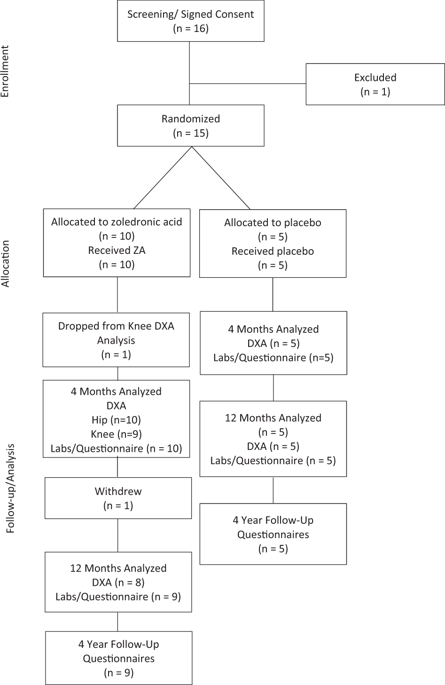当前位置:
X-MOL 学术
›
Spinal Cord
›
论文详情
Our official English website, www.x-mol.net, welcomes your
feedback! (Note: you will need to create a separate account there.)
The effect of zoledronic acid on attenuation of bone loss at the hip and knee following acute traumatic spinal cord injury: a randomized-controlled study.
Spinal Cord ( IF 2.1 ) Pub Date : 2020-02-13 , DOI: 10.1038/s41393-020-0431-9 Christina V Oleson 1, 2 , Ralph J Marino 3 , Christopher S Formal 3, 4 , Christopher M Modlesky 5 , Benjamin E Leiby 6
Spinal Cord ( IF 2.1 ) Pub Date : 2020-02-13 , DOI: 10.1038/s41393-020-0431-9 Christina V Oleson 1, 2 , Ralph J Marino 3 , Christopher S Formal 3, 4 , Christopher M Modlesky 5 , Benjamin E Leiby 6
Affiliation

|
STUDY DESIGN
Randomized double blind, placebo-controlled trial.
OBJECTIVES
To examine the effect of early intravenous zoledronic acid (ZA) on bone markers and areal bone mineral density (aBMD) in persons with acute ASIA Impairment Scale (AIS) A traumatic spinal cord injury (SCI).
SETTING
Two inpatient rehabilitation units.
METHODS
Thirteen men, 2 women, aged 19-65, C4-T10 AIS A SCI, received 5 mg intravenous ZA vs. placebo 12-21 days post injury. Markers of bone formation (procollagen N-1 terminal propeptide [P1NP]), bone resorption (serum C-telopeptide [CTX]), and aBMD by dual-energy X-ray absorptiometry (DXA) for hip (femur-proximal, intertrochanteric, neck), and knee (distal femur, proximal tibia) were obtained at baseline, 2 weeks post infusion (P1NP, CTX only), 4 and 12 months post injury.
RESULTS
P1NP remained unchanged, while CTX decreased in ZA but increased in controls at 2 weeks (mean difference = -97%, p < 0.01), 4 months (mean difference = -54%, p < 0.05), but not 12 months (mean difference = 3%, p = 0.23). Changes in aBMD at the hip favored ZA at 4 months (mean difference 10.3-14.1%, p < 0.01) and 12 months (mean difference 10.8-13.1%, p < 0.02). At 4 months, changes in aBMD favored ZA at the distal femur (mean difference 6.0%, 95% CI: 0.7-11.2, p < 0.03) but not proximal tibia (mean difference 8.3%, 95% CI: -6.9 to 23.6, p < 0.23). Both groups declined in aBMD at 12 months, with no between group differences.
CONCLUSION
ZA administered ≤21 days of complete traumatic SCI maintains aBMD at the hip and distal femur at 4 months post injury. This effect is partially maintained at 12 months.
中文翻译:

唑来膦酸对急性创伤性脊髓损伤后臀部和膝盖骨质丢失的缓解作用:一项随机对照研究。
研究设计随机双盲,安慰剂对照试验。目的探讨早期静脉注射唑来膦酸(ZA)对急性ASIA损伤量表(AIS)创伤性脊髓损伤(SCI)患者的骨标志物和面骨矿物质密度(aBMD)的影响。设置两个住院康复科。方法13名男性,2名女性,年龄19-65岁,C4-T10 AIS A SCI,在受伤后12-21天与安慰剂相比,接受了5 mg静脉内ZA治疗。双能X线骨密度仪(DXA)对髋关节(股骨近端,股骨转子间,骨生成,骨吸收,骨吸收(血清C端肽[CTX])和aBMD的标记在基线,输注后2周(仅P1NP,仅CTX),受伤后4和12个月时获得脖子和膝盖(股骨远端,胫骨近端)。结果P1NP保持不变,而ZA的CTX下降,但在对照组的2周时(平均值差异= -97%,p <0.01),4个月(平均值差异= -54%,p <0.05)增加,但12个月没有(平均值差异= 3%) ,p = 0.23)。髋关节aBMD的变化在4个月(平均差异10.3-14.1%,p <0.01)和12个月(平均差异10.8-13.1%,p <0.02)时有利于ZA。在第4个月时,aBMD的变化有利于股骨远端的ZA(平均差异6.0%,95%CI:0.7-11.2,p <0.03),而不是胫骨近端(平均差异8.3%,95%CI:-6.9至23.6, p <0.23)。两组在12个月时aBMD均下降,两组之间无差异。结论ZA在完全外伤性SCI≤21天后的4个月内可维持髋部和股骨远端的aBMD。这种效果部分维持在12个月。
更新日期:2020-02-13
中文翻译:

唑来膦酸对急性创伤性脊髓损伤后臀部和膝盖骨质丢失的缓解作用:一项随机对照研究。
研究设计随机双盲,安慰剂对照试验。目的探讨早期静脉注射唑来膦酸(ZA)对急性ASIA损伤量表(AIS)创伤性脊髓损伤(SCI)患者的骨标志物和面骨矿物质密度(aBMD)的影响。设置两个住院康复科。方法13名男性,2名女性,年龄19-65岁,C4-T10 AIS A SCI,在受伤后12-21天与安慰剂相比,接受了5 mg静脉内ZA治疗。双能X线骨密度仪(DXA)对髋关节(股骨近端,股骨转子间,骨生成,骨吸收,骨吸收(血清C端肽[CTX])和aBMD的标记在基线,输注后2周(仅P1NP,仅CTX),受伤后4和12个月时获得脖子和膝盖(股骨远端,胫骨近端)。结果P1NP保持不变,而ZA的CTX下降,但在对照组的2周时(平均值差异= -97%,p <0.01),4个月(平均值差异= -54%,p <0.05)增加,但12个月没有(平均值差异= 3%) ,p = 0.23)。髋关节aBMD的变化在4个月(平均差异10.3-14.1%,p <0.01)和12个月(平均差异10.8-13.1%,p <0.02)时有利于ZA。在第4个月时,aBMD的变化有利于股骨远端的ZA(平均差异6.0%,95%CI:0.7-11.2,p <0.03),而不是胫骨近端(平均差异8.3%,95%CI:-6.9至23.6, p <0.23)。两组在12个月时aBMD均下降,两组之间无差异。结论ZA在完全外伤性SCI≤21天后的4个月内可维持髋部和股骨远端的aBMD。这种效果部分维持在12个月。











































 京公网安备 11010802027423号
京公网安备 11010802027423号